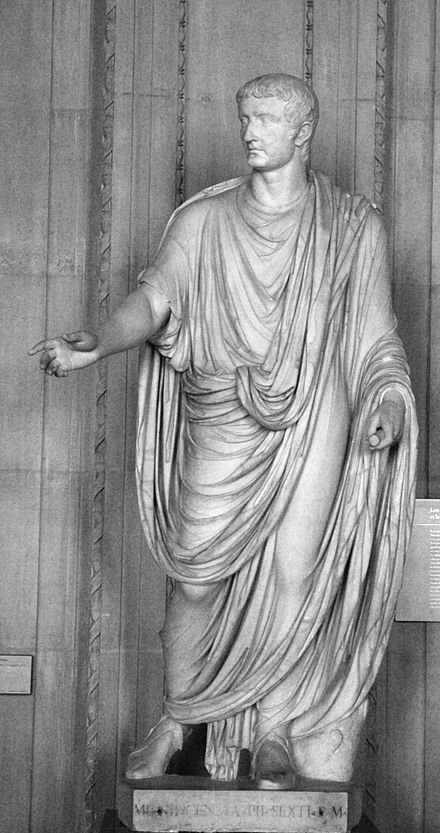Toga
The toga (/ˈtoʊɡə/, Classical Latin: [ˈt̪ɔ.ɡa]), a distinctive garment of ancient Rome, was a roughly semicircular cloth, between 12 and 20 feet (3.7 and 6.1 m) in length, draped over the shoulders and around the body. It was usually woven from white wool, and was worn over a tunic. In Roman historical tradition, it is said to have been the favored dress of Romulus, Rome's founder; it was also thought to have originally been worn by both sexes, and by the citizen-military. As Roman women gradually adopted the stola, the toga was recognized as formal wear for male Roman citizens.[1] Women engaged in prostitution might have provided the main exception to this rule.[2]
The type of toga worn reflected a citizen's rank in the civil hierarchy. Various laws and customs restricted its use to citizens, who were required to wear it for public festivals and civic duties.
From its probable beginnings as a simple, practical work-garment, the toga became more voluminous, complex, and costly, increasingly unsuited to anything but formal and ceremonial use. It was and is considered ancient Rome's "national costume"; as such, it had great symbolic value; however even among Romans, it was hard to put on, uncomfortable and challenging to wear correctly, and never truly popular. When circumstances allowed, those otherwise entitled or obliged to wear it opted for more comfortable, casual garments. It gradually fell out of use, firstly among citizens of the lower class, then those of the middle class. Eventually, it was worn only by the highest classes for ceremonial occasions.
The toga was an approximately semi-circular woollen cloth, usually white, worn draped over the left shoulder and around the body: the word "toga" probably derives from tegere, to cover. It was considered formal wear and was generally reserved for citizens. The Romans considered it unique to themselves, thus their poetic description by Virgil and Martial as the gens togata ('toga-wearing race').[4] There were many kinds of toga, each reserved by custom to a particular usage or social class.
The toga's most distinguishing feature was its semi-circular shape, which sets it apart from other cloaks of antiquity like the Greek himation or pallium. To Rothe, the rounded form suggests an origin in the very similar, semi-circular Etruscan tebenna.[17] Norma Goldman believes that the earliest forms of all these garments would have been simple, rectangular lengths of cloth that served as both body-wrap and blanket for peasants, shepherds and itinerant herdsmen.[18] Roman historians believed that Rome's legendary founder and first king, the erstwhile shepherd Romulus, had worn a toga as his clothing of choice; the purple-bordered toga praetexta was supposedly used by Etruscan magistrates, and introduced to Rome by her third king, Tullus Hostilius.[19]
In the wider context of classical Greco-Roman fashion, the Greek enkyklon (Greek: ἔγκυκλον, "circular [garment]") was perhaps similar in shape to the Roman toga, but never acquired the same significance as a distinctive mark of citizenship.[20] The 2nd-century diviner Artemidorus Daldianus in his Oneirocritica derived the toga's form and name from the Greek tebennos (τήβεννος), supposedly an Arcadian garment invented by and named after Temenus.[21][22] Emilio Peruzzi claims that the toga was brought to Italy from Mycenaean Greece, its name based on Mycenaean Greek te-pa, referring to a heavy woollen garment or fabric.[23]

(Via Labicana Augustus).

